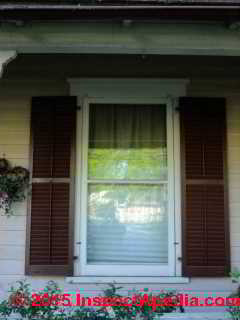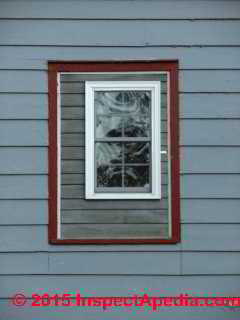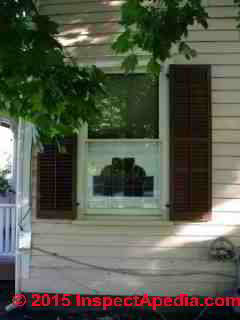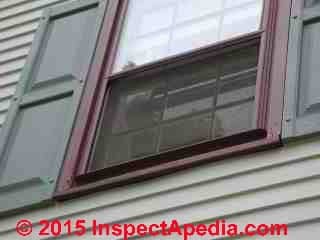 Storm Window Guide
Storm Window Guide
How to choose, install, repair storm windows. Why you should install storm windows.
- POST a QUESTION or COMMENT about storm windows
Storm window information guide:
This article series explains the need for storm windows, how and why to install them, the types of storm windows and indoor or outdoor storm window choices, as well as providing storm window maintenance details such as weep holes or drainage to prevent building leaks, rot, and damage.
Our page top photo shows a traditional wood-framed manually hung and manually-removed storm window on a home in Hyde Park, New York.
InspectAPedia tolerates no conflicts of interest. We have no relationship with advertisers, products, or services discussed at this website.
Guide to Storm Windows: types, selection, installation, repairs
This creative window efficiency improvement was spotted on a home in Hyde Park, New York.
The installer decided to leave the original window frame in place but to frame-in, install siding, and then instsall a smaller double-hung window with an aluminum triple-track exterior storm window in place.
[Click to enlarge any image]
Why Install Storm Windows?
Quoting from WINDOW / DOOR ENERGY EFFICIENT, DOE
Add Storm Windows
If you have old windows in your home, the best way to improve your home's energy efficiency is to replace them with new, energy-efficient windows.
However, if you're on a tight budget, a less expensive option is to use storm windows. Some types of storm windows are also a good option for those living in apartments.
Even though storm windows add little to the insulating performance of single-glazed windows (that are in good condition,) field studies have found that they can help to reduce air movement into and out of existing windows.
Therefore, they help reduce heating and cooling costs.
Shown above, a traditional wood window on a 100 year old home has no storm window installed.
For a home such as this one located in a northern climate, adding a storm window and perhaps low-e glazing can substantially reduce un-wanted heat loss.
OPINION: the DOE comments above may underestimate the benefit of storm windows in areas of high winter winds.
Even without significantly increasing the insulating value of the primary sash, by stopping cold winds from blowing directly across the primary sash glass, a storm window should cut heat loss through the window opening by 1/3.
Watch out: if you don't find and stop air leaks in the building first, the benefit of adding storm windows (as well as other energy saving steps such as adding insulation) may not be realized
See ENERGY SAVINGS RETROFIT LEAK SEALING GUIDE
To obtain the benefit of a storm window the window must not suffer from air leaks. These articles also discuss improvements to window and door energy efficiency:
Types of Storm Windows
In this storm window viewed from below, we show a typical extruded-aluminum framed triple-track storm window. The three tracks provide for an upper storm sash, a lower storm sash, and a screen. In the photo the screen has been lowered and the two glass storm panes are in the upper position.
Storm windows are available for most types of windows.
They can be installed on the interior or exterior of the primary window. They range from the inexpensive plastic sheets or films designed for one heating season, to triple-track glass units with low-emissivity coatings that offer many years of use.
Mid-priced storm windows may use glass, plastic panels, or special plastic sheets that have specific optical qualities.
Those made of polycarbonate plastic or laminated glass also offer a high degree of resistance to breaking during storms and/or from intruders.
For the most part, interior storm windows offer greater convenience than exterior storm windows.
They're easier to install and remove; they require less maintenance because they're not exposed to the elements; and, because they seal tightly to the primary window, they're more effective at reducing air infiltration. Interior storm windows also are often the best choice for apartments and houses with more than one floor.
If you can afford exterior storm windows, you can probably afford some newer, more energy-efficient windows, which will be a better investment.
Glass pane types offer better visibility and longer life than plastic pane types, but glass is heavy and fragile. In general, plastics are most economical for people with small budgets or who live in apartments. However, while inexpensive and relatively easy to install, they are easy to damage.
Plastic panels, such as Plexiglas and acrylics are tougher and lighter than glass, but may scratch easily. Some may turn yellow over time as well. Some plastic films may significantly reduce visibility and degrade over time when exposed to sunlight.
Wood, aluminum, and vinyl are the most common storm window frame materials
. There are advantages and disadvantages to all types of frame materials. Although very strong, light, and almost maintenance free, aluminum frames conduct heat very rapidly. Because of this, aluminum makes a very poor insulating material.
Wood frames insulate well, but they weather with age. They also expand and contract according to weather conditions. Wood-frame storm windows installed during the winter may not close easily during the summer, and those installed during the summer may fit loosely in the winter. They can also be quite heavy and thicker than metal frames.
This can make storage difficult, reduce the view out the window, and reduce the amount of natural light in the room. Wood frames also require the most maintenance. There are, however, aluminum- or vinyl-clad wood frames that reduce maintenance requirements.
Vinyl frames are usually made of polyvinyl chloride (PVC) with ultraviolet light (UV) stabilizers to keep sunlight from breaking down the material.
They, however, may expand and warp at high temperatures, and crack in extremely low temperatures. Also, if sunlight hits the material for many hours a day, colors other than white will tend to fade over time.
Storm Window Sources & Research
- Fisher, Charles E., INTERIOR STORM WINDOWS: MAGNETIC SEAL [PDF] (1984), Window Preservation Brief No. 9, National Park Service, U.S. Department of Interior, Preservation
Excerpt:
The interior storm window system selected by Colonial Williamsburg consisted of a clear acrylic sheet in a polymer frame that contained a flexible magnet on the back side.
When the storm window was set against an adhesive-backed steel strip pre-attached to the historic interior window trim, a magnetic seal was formed (see figure 1).
The advantages to this design solution were the ease of installation without any damage to the original woodwork or sash, and the small visual impact it had on the exterior appearance of the window. - Fisher, Charles E. & Christina Henry, INTERIOR STORMS for STEEL CASEMENT WINDOWS [PDF] (1986) Window Preservation Brief No. 15, National Park Service, U.S. Department of Interior, Preservation - retrieved 2022/10/07, original source: https://www.nps.gov/tps/how-to-preserve/tech-notes/Tech-Notes-Windows15.pdf
Excerpt:
A system to improve the energy performance of the windows was developed by the architect, based on an approach that the firm had specified for other similar projects. It involved the installa tion of a new horizontally sliding storm window unit, mounted on the interior of the window jamb.
The 2 storm panels would run the full height of the opening and would slightly overlap to allow for an effective weather seal (see figure 2).
The intersection of the 2 storm panels thus would align at the vertical mullion of the existing paired casement windows.
Since the interior face of the steel mullion was 2 1/4 inches wide, the visual impact on the windows of the intersection of the frames of the two storm panels would be minimal.
For insect control, especially on the lower floors, a screen panel half the width of the opening was specified, set within a third track of the aluminum subframe... - Muckenfuss, Laura A., & Charles E. Fisher, INTERIOR METAL STORM WINDOWS [PDF] Window Preservation Brief No. 5, NPS, Op. Cit., - retrieved 2022/10/07,
Excerpt:
In searching for an interior storm window that met both the functional requirements and the concerns about visual qualities, the architect chose a commercially available metal storm window system.
The storm window was designed to fit within the existing wooden jamb, thus resulting in minimal damage to historic material (see figure 4). The interior windows were nearly 520,000 cheaper to install than the bids received for exterior storm windows.
Of particular significance , the storm sash were not readily visible from the outside, and on the inside the thin bronze-finished frames blended in well with the decorative finish and fine detailing of the original windows.
Selecting an interior storm window per se had certain inherent advantages in this case over exterior applications:
(1) no obtrusive structural muntins were necessary because wind pressure was not a major factor;
(2) fabrication of the storm windows on the first floor was significantly less expensive since the original windows were squaredoff at the head on the interior unlike the arch shape found on the exterior; and
(3) installation costs would be appreciably lower since problems created by cutting back the decorative terra cotta capitals on the exterior of the second floor openings were avoided. - Trissler, Wayne & Charles E. Fisher, EXTERIOR STORM WINDOWS: CASEMENT DESIGN WOODEN STORM SASH [PDF] Window Preservation Brief No. 3, NPS, Op. Cit., - retrieved 2022/10/07,
Excerpt:
As guidance, the following criteria were established beforehand for designing the new storm windows:
1. The new design had to be sympathetic with the historic character of the building.
2. The windows needed to remain operable to allow for ventilation and also for use as possible fire exits.
3. Energy conservation objectives had to be met.
4. Only minimal damage to the historic windows could occur in mounting the storm windows and inconspicuous hardware had to be used.
5. Provisions had to be made for insect screens. - U.S. DOE, ENERGY STAR® Program Requirements for Exterior and Interior Storm Windows - Partner Commitments [PDF] U.S. Department of Energy, retrieved 2022/10/07, original source: https://www.energystar.gov/sites/default/files/Storm%20Window%20Product%20Specification_Final_0.pdf
- US FEMP PURCHASING ENERGY-EFFICIENT RESIDENTIAL STORM WINDOWS [PDF] retrieved 2022/10/07, original source: https://www.energy.gov/eere/femp/purchasing-energy-efficient-residential-storm-windows
Excerpt:
The Federal Energy Management Program (FEMP) provides acquisition guidance for residential storm windows, a product category covered by ENERGY STAR efficiency requirements.
Federal laws and requirements mandate that agencies purchase ENERGY STAR-qualified products or FEMP-designated products in all product categories covered by these programs and in any acquisition actions that are not specifically exempted by law.
FEMP's acquisition guidance and associated ENERGY STAR efficiency requirements for residential storm windows are technology neutral, meaning that one technology is not favored over another.
However, ENERGY STAR's product specification requirements are limited to products that meet the definition of a residential storm window as specified in ENERGY STAR's storm window product specification information. - Park, Sharon C., AIA, THERMAL RETROFIT of HISTORIC WOODEN SASH USING PIGGYBACK STORM PANELS [PDF] (1984), Window Preservation Brief No. 8, NPS, Op. Cit., - retrieved 2022/10/07
Excerpts:
The total cost of repairing the historic wooden windows, weatherstripping and retrofitting the storm panels was under $100 per window opening. This was a 66% saving over the original proposal to use a replacement metal-framed thermal glass unit.
Several factors combined to make the retrofit a cost effective solution. The use of traditional tools and standard woodworking techniques ensured that the work could be easily carried out at the site by the subcontractor. ...
Furthermore, material costs were low and the workmen established an efficient method for repairing and upgrading the existing windows.
The low cost of the retrofit and the added insulating qualities of the upgraded wooden windows provided the owner with a cost-effective solution (see figure 5).
The architect computed that with the combined benefits of low initial expense in retrofitting the historic windows and the decreased fuebills associated with the improved thermal performance of the windows, the owner should have a complete return on his investment in 7 years.
Reader Comments, Questions & Answers About The Article Above
Below you will find questions and answers previously posted on this page at its page bottom reader comment box.
Reader Q&A - also see RECOMMENDED ARTICLES & FAQs
On 2020-05-24 - by (mod) -
Certainly, Sarah, though installation and removal is a bit less convenient.
At the very top photo on this page, click to enlarge it and you'll see that the storm window is held in place with turnbuckles.
On 2020-05-23 by Sarah Turnbull
Just to clarify my question: The sashes won't be flush with the frame, so turn-button catches won't work.
We would like to install wooden storm sashes, but our windows don't have much depth in the frame. What could we use instead of turn buttons to hold the sashes in place?
On 2020-01-23 - by (mod) -
Re-posting without Gus's advertisement for storm windows
gus white said:
I didn't realize that you can get storm windows that will add energy efficiency. We are talking about getting storm windows for our new home, so it can be safe from the elements of the climate, and it will be important for us to know that we are getting the best ones.
When we go shopping for some, I will be sure to ask about their energy efficiency
Question: plastic smell from aluminum storms
(Feb 26, 2012) Anonymous said:
We experience a plastic / metallic smell that occurs when our aluminum exterior mounted storm windows are closed and the sun hits them. It is a distinct odor. Is it common? Windows have been installed for 12 years.
Reply: check for odors from plastic screen material
(July 30, 2012) steve said:
Wow, talk about cobbling it up. That pic of the metal pieced into the sill looked terrible. It was just bent over the sill, not even fitted to it.
Looked like a half assed job to me. I would have tore it all out and replaced the entire sill & what ever framing was rotted then installed new metal instead of piecing it together.
Reply:
Steve, thanks for the comments - we agree. Too often people go through the motions of fixing a problem or installing something, with no real understanding of or concern for avoiding future trouble.
I call it the "peanut butter" school of construction - the installer thinks of his/her job as "buying stuff and spreading it like peanut butter, anywhichway on the building, and getting paid and leaving" - the job is guaranteed until the contractor's truck leaves the driveway.
Question: which storm window sash should be uppermost?
(Jan 12, 2013) Jason said:
For winter weather, should three-track storm windows have the outside glass storm up and middle down? Or, the other way around? We seem to have moisture (even with weep holes cleaned out) on the storm windows.
Reply:
Jason picture the direction of water running down a storm window. The uppermost storm window should be the outermost sash too so as to prevent water from the upper sash from entering inside the lower one.
Question: air conditioner condensate leaks into window sill with clogged storm weep holes
(Nov 11, 2014) Ron said:
I own a home I used to live in and now am renting it out. It is 1 1/2 story - there is a bedroom over the living room with a dormer window with 3 track exterior storm window.
I cleaned the space between the inside window and storm, including weep holes 6 months ago. Recently after several days of heavy rain I was notified that a sticky black ooze dripping down the living room wall in the area under the dormer. 3 different contractors told me it was not the gutters or the roof.
One contractor noted dirt in the weep holes of the upstairs window. He cleaned it and told the tenants that this is what caused the ooze.
A few days later I noted water damage to the ceiling, with in a week a 3.5' x 9' area of the ceiling had fallen in and the wall and ceiling paint is pealing in a much larger area. The ceiling is plaster, with fiber board directly under it and filled with cellulose.
The tenants had been using an air conditioner in the upper window. The air conditioner was removed when I got there, neither the storm window or screen had been replaced. I also noted window air conditioners in two other windows, both were tilting in toward the house, rather than out.
I have owned that house for over 20 years and never had a problem like this. It is important to understand why this happened to prevent it in the future.
After the weep holes were opened a cup of water was poured into the window sill and some of the water escaped through the weep hole but much of it leaked into the Living room.
My understanding is that the weep holes are intended to drain a small amount of water, not large amounts that would be come from a pouring rain when both the screen and storm are removed. Even the screen would deflect rain, minimizing the amount of water filling that space.
Given what I saw with the other air conditioners it is highly probable that water from the air conditioner leaked into this space as well. Hoping someone will share their knowledge and experience or point to a Reference on this topic. THANK YOU!
Reply:
Ron
Sounds like any or all of several problems
- leaks in the window sill allow water into the wall cavity from any of several possible indoor or even outdoor points
- weep openings clogge and. Or undersized
- draining air conditioner condensate into the window sill
I'd have to see the window from inside and out.
And now I suspect a mold reservoir in the wall and ceiling below.
...
Continue reading at SITE BUILT DOUBLE GLAZED WINDOWS or select a topic from the closely-related articles below, or see the complete ARTICLE INDEX.
Or see these
Window Articles
- AIR LEAK DETECTION TOOLS
- ENERGY SAVINGS in BUILDINGS
- STORM WINDOW GUIDE - home
- SPONTANEOUS GLASS BREAKAGE NiS
- STORM WINDOW INTERIOR - energy savings from interior storm windows, how to calculate energy savings from retrofit interior storm windows
- STORM WINDOW PLASTIC CHOICES
- STORM WINDOW WEEP HOLES
- SUNGAIN, FILMS, LOW-E GLASS - for reducing un-wanted window glazing heat gain or heat loss
- VINYL SIDING or WINDOW PLASTIC ODORS
- WINDOW / DOOR AIR LEAK SEALING HOW TO
- WINDOW INSULATION OPTIONS
- WINDOW / DOOR ENERGY EFFICIENT, DOE
- WINDOW GLAZING BASED on CLIMATE
- WINDOW SHADING, SCREENING
Suggested citation for this web page
STORM WINDOW GUIDE at InspectApedia.com - online encyclopedia of building & environmental inspection, testing, diagnosis, repair, & problem prevention advice.
Or see this
INDEX to RELATED ARTICLES: ARTICLE INDEX to DOORS & WINDOWS
Or use the SEARCH BOX found below to Ask a Question or Search InspectApedia
Ask a Question or Search InspectApedia
Try the search box just below, or if you prefer, post a question or comment in the Comments box below and we will respond promptly.
Search the InspectApedia website
Note: appearance of your Comment below may be delayed: if your comment contains an image, photograph, web link, or text that looks to the software as if it might be a web link, your posting will appear after it has been approved by a moderator. Apologies for the delay.
Only one image can be added per comment but you can post as many comments, and therefore images, as you like.
You will not receive a notification when a response to your question has been posted.
Please bookmark this page to make it easy for you to check back for our response.
Our Comment Box is provided by Countable Web Productions countable.ca
Citations & References
In addition to any citations in the article above, a full list is available on request.
- Basic Housing Inspection, US DHEW, S 352.75 U48, p.144, out of print, but is available in most state libraries; New York State version, ca 1955, source of our window parts and window repair sketches.
- Mark Cramer Inspection Services Mark Cramer, Tampa Florida, Mr. Cramer is a past president of ASHI, the American Society of Home Inspectors and is a Florida home inspector and home inspection educator. Mr. Cramer serves on the ASHI Home Inspection Standards. Contact Mark Cramer at: 727-595-4211 mark@BestTampaInspector.com
- Our recommended books about building & mechanical systems design, inspection, problem diagnosis, and repair, and about indoor environment and IAQ testing, diagnosis, and cleanup are at the InspectAPedia Bookstore. Also see our Book Reviews - InspectAPedia.
- In addition to citations & references found in this article, see the research citations given at the end of the related articles found at our suggested
CONTINUE READING or RECOMMENDED ARTICLES.
- Carson, Dunlop & Associates Ltd., 120 Carlton Street Suite 407, Toronto ON M5A 4K2. Tel: (416) 964-9415 1-800-268-7070 Email: info@carsondunlop.com. Alan Carson is a past president of ASHI, the American Society of Home Inspectors.
Thanks to Alan Carson and Bob Dunlop, for permission for InspectAPedia to use text excerpts from The HOME REFERENCE BOOK - the Encyclopedia of Homes and to use illustrations from The ILLUSTRATED HOME .
Carson Dunlop Associates provides extensive home inspection education and report writing material. In gratitude we provide links to tsome Carson Dunlop Associates products and services.




